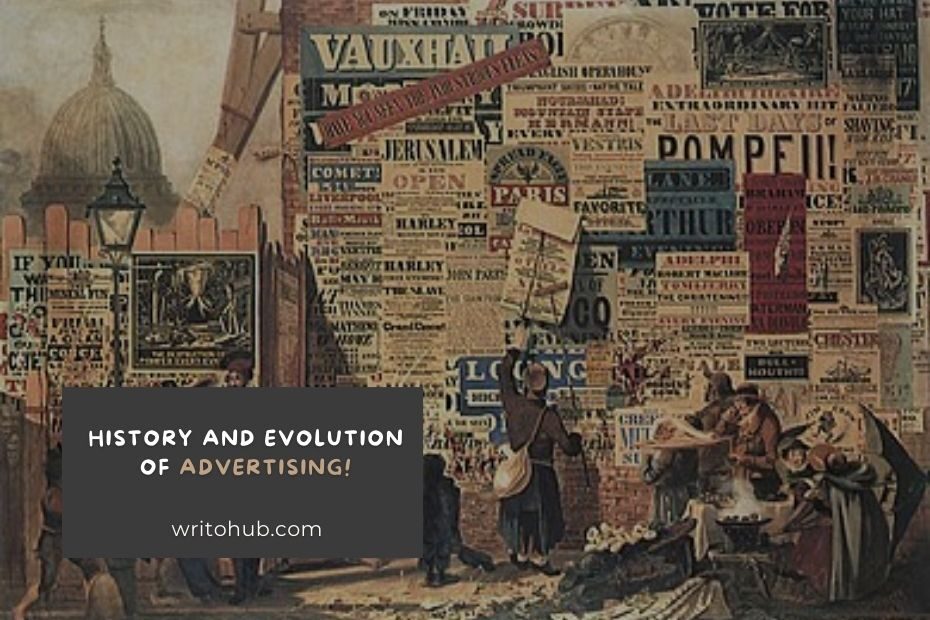Introduction
Advertising, as an integral part of human communication and commerce, has evolved significantly over time.
From its early beginnings in ancient civilizations to the modern era of digital advertising, this form of communication has continuously adapted to meet the changing needs of businesses and consumers.
In this article, we will explore the fascinating history and evolution of advertising, examining its various stages and milestones.
Ancient Origins and Middle Ages
Advertising has roots dating back to ancient civilizations, where early forms of marketing and promotion were practiced.
Two notable examples include:
- Ancient Egypt’s Use of Papyrus: Ancient Egyptians utilized papyrus to create posters and sales messages, which were displayed in public spaces to inform and attract potential customers.
- Pompeii’s Advertising Artifacts: Archaeological excavations in Pompeii have revealed the presence of advertising signs, painted murals, and inscriptions on walls, showcasing the ancient city’s thriving commercial activities.
During the Middle Ages, town criers played a crucial role in disseminating information and advertisements to the public.
They would traverse the streets, making announcements on behalf of businesses and authorities.
The Printing Press and Print Advertising
The invention of the printing press in the 15th century revolutionized advertising by enabling the mass production of written materials.
Key developments during this period include:
- The emergence of Newspapers and Pamphlets: With the advent of printing, newspapers, and pamphlets became popular mediums for advertising. Businesses could now reach a wider audience by placing advertisements in these publications.
- William Caxton’s Handbill: Considered one of the earliest successful print advertisements, William Caxton’s handbill from the late 15th century promoted a book he had printed. This marked an early example of using printed materials to attract customers.
Advancements in the 18th and 19th Centuries
The 18th and 19th centuries witnessed further advancements in advertising techniques and mediums.
Some notable developments include:
- Posters, Billboards, and Trade Cards: Posters and billboards began to emerge as effective advertising mediums during this time, capturing the attention of passersby and promoting products and services. Additionally, trade cards were widely used to promote businesses and facilitate customer loyalty.
- Rise of Mass Circulation Newspapers: The Industrial Revolution and the growth of urban populations led to the rise of mass-circulation newspapers. Advertisers recognized the potential of reaching a larger audience and began placing advertisements in these publications.
- Pioneering Advertising Agencies: The late 19th century saw the establishment of pioneering advertising agencies such as J. Walter Thompson and N.W. Ayer & Son. These agencies played a pivotal role in shaping modern advertising by offering comprehensive services to clients and employing innovative marketing strategies.
The Golden Age of Advertising
The 20th century brought about significant advancements in technology and communication, leading to the golden age of advertising.
Key developments during this period include:
- Radio and Television Advertising: The invention of radio and television opened up new avenues for advertisers. Businesses started sponsoring radio programs and television shows, utilizing catchy jingles and memorable slogans to create brand awareness.
- The First Television Commercial: On July 1, 1941, the Bulova Watch Company aired the first-ever television commercial, marking a groundbreaking moment in advertising history. The 10-second spot aired before a baseball game, reaching thousands of viewers.
The Digital Revolution
The advent of the internet in the late 20th century brought about a paradigm shift in advertising.
The digital revolution introduced new methods and channels for reaching consumers. Key developments during this period include:
- Banner Ads, Pop-ups, and Search Engine Marketing: The internet enabled the use of banner ads and pop-ups on websites to promote products and services. Additionally, search engine marketing became prevalent, allowing businesses to target users based on their search queries.
- Rise of Social Media and Influencer Marketing: Social media platforms like Facebook, Twitter, and Instagram emerged as powerful advertising channels. Influencer marketing gained prominence, leveraging the influence of popular individuals to endorse products and engage with their followers.
Personalization and Data-Driven Advertising
As technology advanced, advertising became more personalized and data-driven.
Key developments during this period include:
- Shift towards Personalized and Targeted Messages: Advertisers began tailoring their messages to specific demographics and individual preferences, leveraging data to create more relevant and engaging advertisements.
- Advancements in Technology and Data Collection: Technological advancements, such as artificial intelligence and machine learning, enabled advertisers to collect and analyze vast amounts of data. This data-driven approach allowed for more precise targeting and improved campaign effectiveness.
- The dominance of Digital Advertising, Mobile Advertising, and Video Ads: Digital advertising surpassed traditional forms of advertising, with mobile advertising and video ads gaining significant traction. With the rise of smartphones and streaming platforms, advertisers found new ways to engage with consumers.
Conclusion
The history and evolution of advertising reflect the continuous adaptation and innovation within the industry.
From ancient Egypt to the digital age, advertising has evolved alongside human communication and commerce.
As technology advances further, the future of advertising holds exciting prospects, with augmented reality, virtual reality, and artificial intelligence poised to shape the industry in remarkable ways.
